History
History
History
The historic Waumbek Golf Club offers the most picturesque views of any golf course in New England. Originally designed in 1895, Waumbek is the oldest golf course in the state of New Hampshire, offering breathtaking views of the Presidential Range on every hole. Step back in history to experience 18 holes designed to honor the natural contours of the terrain.
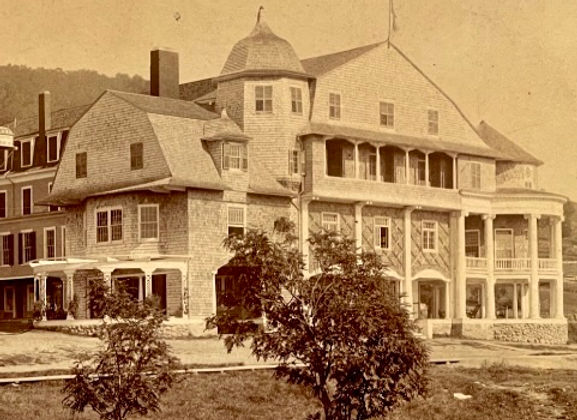
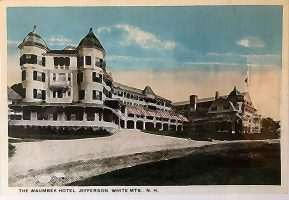
The Waumbek Hotel
The town of Jefferson, founded in 1796, became recognized as a tourist destination in the mid-19th century, in part through the writings of Unitarian minister Thomas Starr King. He convinced a local hotelier to build a larger hotel, called the Hotel Waumbek, in 1860. The availability of railroad transportation greatly increased the tourist trade in subsequent decades, and the hotel was repeatedly enlarged. By the 1890s it was one of the state’s grand hotels, accommodating up to 500 guests.
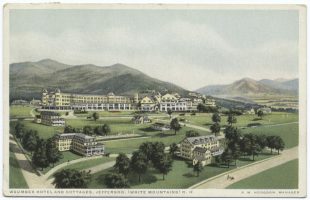
Waumbek Cottages
During the 1880s, a trend began in these resort properties to build separate houses for some of the hotel guests, and other long-time guests also purchased adjacent properties from real estate promoters to build their own, while taking advantage of the hotel's amenities. At the Hotel Waumbek, these trends resulted in the construction of eleven separate "cottages" near the hotel between 1889 and 1900. A major fire in 1928 destroyed the hotel and three cottages, two more were demolished later in the 20th century.
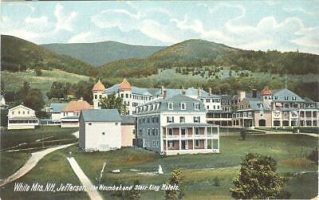
Historic District
The Waumbek Cottages Historic District was added to the New Hampshire State Register of Historic Places on October 31, 2005. Located on Cottage Road and Starr King Road, these six "cottages" are all that survive of the large late-19th century resort complex that included the hotel and eleven cottages. The landscape and setting feature views of the White Mountains to the south. The cottages are surmised to have been designed, based on similarity to other work, by Alfred Barlow, who designed a major addition to the hotel. All of the cottages are in the Shingle style, with Queen Anne style porches.
Explore the Stories Behind our Clubhouse Images
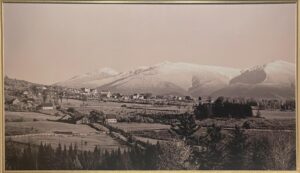
Jefferson And The Presidential Range
-White Mountains-
Copyright 1900 Detroit Photographic Company
What a difference 125 years makes! This 1900 photo of Jefferson was taken from atop the hill on the Lancaster side of today’s Santa’s Village. The road traveling up the hill in the photo towards Jefferson is Route 2. Today the woods and farm fields occupying the bottom third of the image would be Santa’s Village on the right and The Lantern Inn and Campground to the left.
Extraordinary in the details it captures, this interesting perspective of Jefferson showing the Waumbek Hotel with its associated buildings exemplifies the incredible vista of the Presidential Range from Jefferson’s vantage point. It reinforces The Reverend Thomas Starr King’s 1859 proclamation that “Jefferson Hill may without exaggeration be called the ultima thule of grandeur in an artist’s pilgrimage among the New Hampshire mountains, for at no other point can he see the White Hills themselves in such array and force.”
It is interesting to note how many more buildings occupied Jefferson Hill at the beginning of the 1900’s as compared to today.
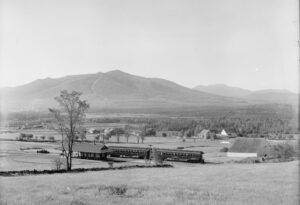
Cherry Mtn. And Franconia Range From Waumbek House
-White Mountains-
1900
This amazing photograph shows why Jefferson, NH, with many hotels including the Waumbek, attracted tourists the world over who came to marvel at its scenery.
Taken with an 8” x 10” glass negative the clarity of the photograph is astounding. From the foreground with the Waumbek’s train station depot, railroad cars and porters, to the still very visible scar of the1885 Cherry Mountain Landslide in the distance, there is much to see in this image.
The Waumbek’s golf course, starting with nine holes in 1895 and expanding to eighteen in 1899, is the oldest course in the State of New Hampshire. The rail line to the Waumbek cut through the course as it made its way to the depot, with passengers disembarking to a summer season of opulence and leisure.
From the verandas of today’s Waumbek Golf Clubhouse, the train station was just several hundred feet away. The rail line to the hotel existed from 1892 until 1922. At that point the advent of the automobile made the longer seasonal stays at the grand hotels a thing of the past, with motorists following their daily whims as they traveled through the White Mountains.
As you look at the photograph, on the station platform you see 3 porters with large trunks as if waiting for the train to arrive. If you look closer on the upper left hand side of the photo you will notice the plume of steam from a locomotive engine at or just leaving Meadows Station. This train just may be the one the porters are awaiting.
The Cherry Mountain Landslide of July 10, 1885, destroyed the new farmhouse Oscar Stanley and family were to move into that very day. It was the replacement for their previous home which had burned 6 weeks earlier. Farm hand Donald Walker was trapped in the crushed barn and perished from his injuries 4 days later. The Slide was the main attraction for hotel guests throughout the White Mts. for the remainder that tourist season.
Many of the homes you see in this photo still exist today, helping us to get our bearings and relate to the past as it is so eloquently shown in this photo.
This photo by the Detroit Photographic Co., and is one of a number of Jefferson photos produced by the company during this era.
Putting Gallery Waumbek Hotel
-1915-
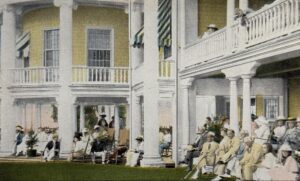
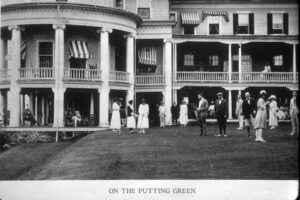
A great depiction of a relaxing summer day at the Waumbek, the people in this photo are watching some of their fellow patrons putting on the green that was at the east end of the original Waumbek Hotel. Remnants of the green area are still visible today almost 100 years after the hotel, the centerpiece of Jefferson, burned in 1928.
Waumbek Foliage
A beautiful seasonal image of the Waumbek complex probably taken in the early 1950s, this shows what remained of the resort after the main hotel, previously located on the north side of Route 2, burned in 1928. During this period, the Waumbek complex hosted tennis and golf tournaments. In the 1970s the hotel was the home the White Mountains Festival of the Arts with its cultural programming and concerts. All of the hotel buildings pictured here are now gone, torn down in the 1980s and 1990s.
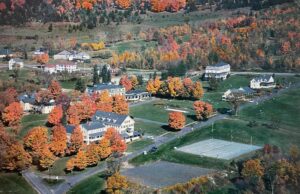
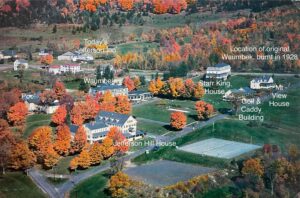
The second photo shows the names of all the buildings.
The Waumbek – From Boarding House to Grand Hotel
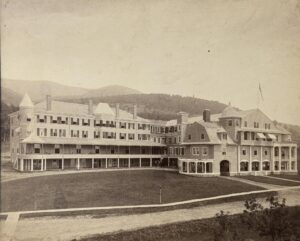
In 1889, after the purchase of the Waumbek by the Jefferson Hotel and Land Company, the establishment began its journey from large boarding house to one of the area’s finest grand hotels. The group wasted no time in securing the New York architectural firm of Carrère and Hastings to bring a real sense of elegance to the Waumbek. The firm’s contribution to the hotel’s new look was the front section of the building, on the right in this photo. With the large rotunda on the far right and the carriage pull through on the left, this was the hotel’s 4th major enlargement since its beginning as a simple 40’ X 60’ structure in 1860.
The Jefferson Hotel and Land Company again added to the hotel in 1892, the same year the Waumbek railroad spur was built from the Meadows Station to the hotel. This addition, to the left in this photo, was 112 feet in length, and it housed the dining room and a number of additional guest rooms. According to the White Mountain Echo, one of several summer resort newspapers, this brought the capacity of the hotel to about 300. This addition was probably built by Manassah Perkins and Moses McDonald. Manassah was the son of Nathan R. Perkins, and Manassah was involved in railroad operations on various lines in Jefferson and also management of the hotel. McDonald was a carpenter from Whitefield. Over the next decade the hotel would continue to expand, increasing its capacity to almost 600 guests.
The Waumbek and Cottages, Jefferson
-White Mountains-
1900
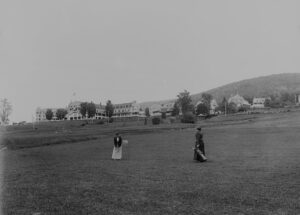
This photo shows the Waumbek Hotel and its associated cottages in all their grandeur. Adding to the aesthetics of this image are the two ladies on a green of the hotel’s eighteen hole golf course. Originally built as nine holes in 1895, the course was expanded to eighteen in 1899, the year before this photo was taken. It is the oldest course in the State of New Hampshire.
The Waumbek was first built in 1860 and expanded numerous times, culminating in the magnificent structure pictured here. The Waumbek Hotel and several cottages burned on May 9th, 1928. The remaining annexes and cottages carried on the Waumbek name as a tourist resort until 1980. Six of the cottages, now privately owned, are all that remain from the Grand Hotel era. They are listed on New Hampshire’s and the National Registers of Historic Places.
Main St. Jefferson, NH Looking East
-1910-
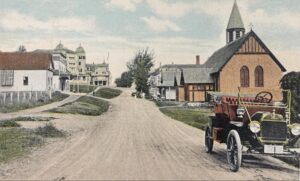
This view, taken from just east of The Old Corner Store, shows a Main St. in Jefferson very different from what exists today. None of the buildings depicted in this photo remain. On the left, the Post Office, Roberts General Store and the Waumbek Hotel. On the right the Holy Trinity Episcopal Church, barber shop, and the Starr King House. For reference, Starr King Rd. today is between Roberts General Store and the Waumbek Hotel.
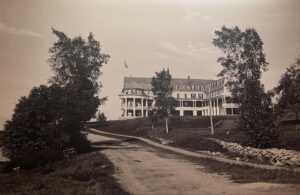 Approach To The Waumbek, Jefferson
Approach To The Waumbek, Jefferson
-1900-
Traveling west along Rt. 2 from Randolph, the rolling golf course would be seen on the left, while ahead on the right the prominent rotunda of The Waumbek Hotel’s eastern facade welcomed you to Jefferson Hill.
The Waumbek, one of New Hampshire’s Grand Hotels, began in 1860 as a 40’ x 60’ boarding house. The idea behind it and its location were suggested by the Reverend Thomas Starr King to local tavern owner Benjamin Hunking Plaisted. King, a Unitarian minister from Boston who traveled frequently to the region, was a well known orator. He would go on to play a significant role in the American Civil War by convincing California to stay with the North.
Plaisted, meanwhile, followed King’s advice and over the ensuing forty years, with several owners, the hotel underwent a number of renovations and additions, the original building being swallowed up by the expansions around it. By the time of this photo, it was owned by The Waumbek Hotel and Land Company, a consortium of prominent business men. While on its own The Waumbek would house over five hundred guests, the group also bought up the Jefferson Hill House, Plaisted House and Starr King House, hotels all adjacent to the Waumbek, to meet the demands of the growing clientele. In addition, there were eleven “cottages” associated with the hotel, six of which survive today. The hotel boasted the State of New Hampshire’s first nine hole golf course in 1895, expanding to eighteen holes by 1899. It also had its own 4 mile railroad spur line from the Meadows serving the Waumbek and Jefferson Hill from 1892-1922. The depot for this line was just several hundred feet from today’s Waumbek Golf Clubhouse.
This photo by the Detroit Photographic Co. was produced on an 8” x10” glass plate negative, and is one of a number of Jefferson photos produced by the company during this era.
Sheep on the Waumbek Golf Course
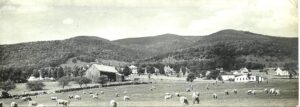
This photo, taken about 1910, shows the expanse of the Waumbek resort, from the south side of what is known today as Meadows Rd. or Rt. 115A. The hotel, along with a number of cottages and the carriage house to the lower right are visible.
Several dozen sheep are grazing on the Waumbek Golf Course, helping to keep it trimmed. Sheep were also a valuable commodity in town. An 1899 hotel ledger reported 6,400 pounds of lamb being supplied by Jefferson farmers. The hotel was an economic engine for the community, also requiring in 1899 6,000 pounds of chicken, 3,100 pounds of veal, 1900 dozen eggs from one farmer, and 12,500 pounds of butter from another.
One local farmer who supplied the Waumbek with lamb was Lucius T. McIntyre. His house and barn are still standing today next to the fire pond across from the Old Corner Store.